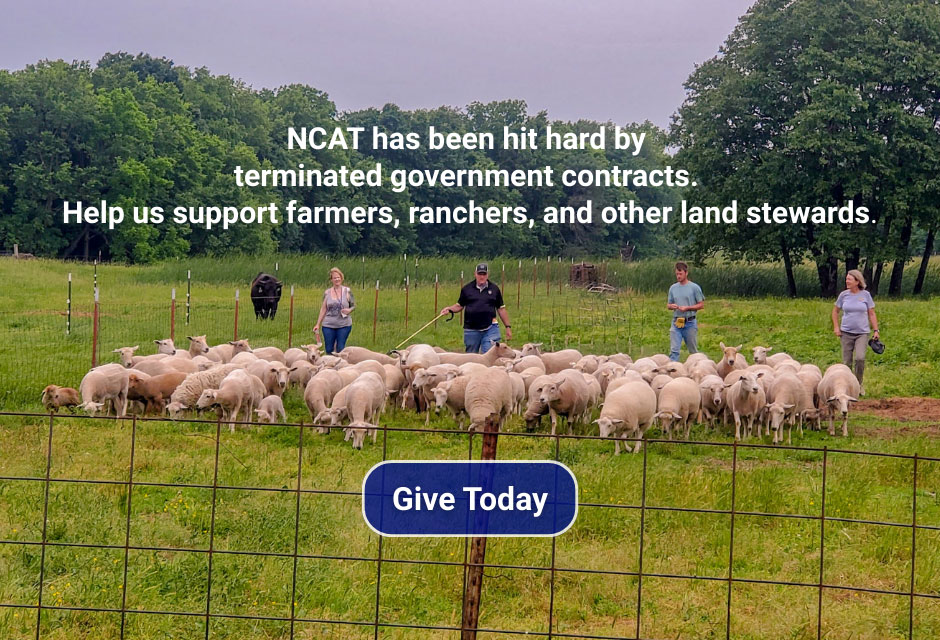Rethinking Crop Insurance
By Jeff Schahczenski, NCAT Agricultural and Natural Resource Economist
I have been awakened to a re-evaluation of risk and uncertainty. Going to the grocery store has – hopefully only for a short time – become more risky. I also have been thinking more and more about how are personal and societal understanding and measurement of uncertainty is changing. It is more risky to go to the grocery store because of the increased level of uncertainty that we will arrive home healthy. Have these changes in risk and uncertainty brought on by this pandemic impacted the need and desire to re-examine crop insurance?
Federally subsidized crop insurance fundamentally address two categories of risk. First, there is production risk, which derives from the uncertainty of yield related to the disruption of the normal growth of crops and livestock as affected by weather, disease, pests and other factors. This is the historic and most common form of crop insurance referred to generally as “multi-peril” insurance. This risk does not seem likely to be largely impacted by the pandemic.
The other major risk category is called price or market risk and is caused by the uncertainty of what the price of the product will be at the time it is produced and ready for sale. This risk also sometimes includes the uncertainty of the costs of the inputs needed to produce the product since this risk is also market-based. These risks will likely be impacted significantly by the pandemic.
Fortunately, at least for a major proportion of agriculture producing major commodity crops such as corn, soybeans, wheat, and cotton, there is widely available revenue protection which covers both production (yield) and market (price) risks. Unfortunately, there are also many types of crops and livestock products for which revenue insurance is not available at all or not available in the county in which the farmer farms. For example, in California in 2019 only about 1,600 of a total of 32,590 policies sold were revenue-based, leaving much of California agriculture without protection related to market or price risk.[1]
The exception to this case is the unique policy known as Whole-Farm Revenue Protection (WFRP), which does provide revenue protection based on the historic revenue history of a whole farm rather than a specific crop or livestock product. Though available nationwide, this policy has not been widely utilized because of several factors which NCAT and others have been working to improve. Nonetheless, if price or market risks continue to rise over the next few years, WFRP may become an option to consider for the many producers of crop or livestock products for which revenue insurance is not available.
Quarantine
Another word that has entered our lives forcefully is quarantine. In federal crop insurance the definition of quarantine is very specific and in most cases unless specifically added to a policy (called an endorsement) it is not an insurable cause of loss and thus generally not covered under most policies. RMA defines[2] quarantine as specific action taken by a public authority for a specific pest that:
- Requires the destruction of your insured crop or the plants on which your insured crop is growing; or
- Does not permit the insured crop to be harvested, sold, transported, transferred, or otherwise restricts it from movement from the location where it was produced to the location of any buyer.
Fortunately COVID-19 virus is not a pest that has led to crop or livestock related quarantines, but the consideration of this topic is becoming more important for future public policy consideration.
Adjustments to Date
As of the date of writing, the U.S. Dept. of Agriculture Risk Management Agency (RMA) has made some adjustments to the normal process of acquiring crop insurance for the 2020 production year. For the most part these adjustments have been to encourage movement toward avoiding actually meeting with your crop insurance agent. Since the closing sales dates for most crop insurance products has passed, the adjustments are being made to delay the delivery of important paper work such as filing of documents such as production reporting requirements, written agreements (a special policy option), and, importantly, payment of premiums. For details see the RMA website under the What’s New link (https://www.rma.usda.gov/News-Room/Whats-New) or call or email your crop insurance agent.
Stay Tuned for a Different Future
When life changes rapidly we have hopes to return to a sense of stability but we also usually learn new ways to adapt and even change the structure of our lives. Crop insurance, like all insurance, is a function of our personal and public common risk aversions. Some of us are gamblers, some of us are not. And the general idea of pooling our resources to protect against risk is in part the essence of insurance, if not of government in general.
Visit our ATTRA website for some resources to explore or re-explore the risky business of farming and ranching and the role crop insurance might play in your future success.
[1] Source: Risk Management Agency, Summary of Business accessed on March 30, 2020.
[2] Source: RMA, Quarantine Endorsement Pilot at https://legacy.rma.usda.gov/policies/2011/11-qe.pdf












